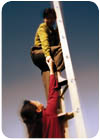
“Willie, I want to introduce you to Chuck Smith. Chuck’s going to be helping us with our behavior-based safety process. We’ve been at it for a long time and it needs a jump-start.â€
Willie had been resisting getting more involved in safety, especially the BBS process, and Joe thought this might be a good time to introduce him to some new thoughts.
“Alright Chuck, you know all about me, don’t you? I’ll tell you right now — I can’t be a safety coach!†Willie was already defensive.
Chuck realized he had an opportunity to break down some walls with Willie and thought this might be a good time to speak up.
Walls of resistance
“As a consultant, I get to work with some really great companies that are getting to zero-accidents and zero-recordables,†said Chuck. “Some have been doing it for five or six years and even more. But two things are necessary beyond the support you already have at the top. First, we need more involvement — more engagement from supervisors and with workers like you. Two, we need to make the most of everyone’s coaching skills. It’ll take some time and work but we can get there.â€Willie smiled and shook his head cautiously and then looked at Joe. “Hey Joe, please — no more. I don’t want to be an observer or a safety coach!â€
Joe smiled. “Let’s listen to Chuck. He has some great stuff to share with us over the next few weeks.â€
“Thanks Joe.†Chuck was ready to keep talking about the direction that was necessary to move to a higher level of safety performance. He wanted to discuss three keys: magnitude of change, flexibility of change, and durability of change.
Magnitude of change
“We need more involvement and feedback so we can get different kinds of positive changes,†said Chuck. “Some of your own group’s performance scores have drifted into the low 80s and we want to increase that right away — to 100 percent or close to it. This is the first type of change that’s needed. In psychology, we call it magnitude of change. A fancy term that means we can move from one level, to a much higher level, very quickly and efficiently.â€â€œYeah, Joe will like that – up another level without a lot of work,†said Willie.
Willie was trying to be funny to deflect some of the early tension. Chuck had a lot more to say but didn’t want to give the guys too much, too soon.
“I can’t possibly tell you guys everything we want to do because I’ll have your heads spinning. And if I feed you too much you’ll bring it back up. I’m sure you know what I mean,†Chuck smiled.
“There are a number of ways to get greater magnitude of change,†he continued. “One is to use very small rewards on the spot and to praise and reinforce specific actions. But the rewards have to be small, like a token for some soda. They should also be used to have fun but in spontaneous and informal ways. These little rewards should be thought up by everyone — but supervisors and the general workforce should be involved in using them. We also need to get more people to set the goals that we want to achieve. Again, the recognition or rewards we use with goal-setting need to be clearly tied to the group’s performance scores. You know what I’m saying guys?â€
Joe wasn’t saying much at all, but as a supervisor, he had first-hand experience about how well small token rewards and goal-setting worked when he was very specific with his feedback.
Flexible change
“The second kind of positive change is what we call flexibility of change,†said Chuck. “It’s when people start working safer at work and at home in ways we didn’t even think about. People start working safely in ways we didn’t begin to identify on a given inventory. To do this we need to get more people involved as safety coaches — workers and supervisors in some cases. The feedback we give has to be specific and targeted for the tasks. It has to help make safety expectations crystal clear. Also, I like to talk about the 3Fs — good feedback needs to be Fast, Frequent and as Favorable and Genuine as possible.â€
The conversation was going on for just a few minutes and Chuck knew that he needed to keep it short — but to his surprise, Willie was showing some interest.
Durable change
“No more big words — and that’s 3Fs and a G!†Willie, always the jokester, was getting curiously drawn into Chuck’s discussion.â€â€œI just have one big word left Willie — it’s durability of change. You see, when we help everyone become better coaches, storytellers, and better at giving persuasive two-way feedback, everybody starts to realize that they need to work more safely for themselves, their co-workers, and their families. Not so much for this company — but for themselves and their loved ones! You and everyone else will become safety leaders and will want to work safely even when nobody’s around. Even when you’re tempted to take a short-cut! That means 24/7 — at work and at home.â€
“We know what you mean,†Joe spoke up. “And I know my people are going to start scoring my support as a safety coach with the new upward feedback card. I’ll be held accountable with an all new scorecard! Some of our workers don’t think we supervisors do enough safety coaching. That’s probably true and it should be a normal part of our jobs.â€
Willie chimed in: “I agree, Joe. Hey Chuck — I’m looking forward to hearing more but right now I gotta go.â€
Joe looked at Chuck as Willie took off. “I think Willie’s interested and he can become a champion for safety too!â€
Sidebar: Three types of change
Magnitude of change means we can move from one level to a much higher level, very quickly and efficiently. There are a number of ways to get greater magnitude of change. One is to use very small rewards on the spot and to praise and reinforce specific actions.Flexibility of change occurs when people start working safer at work and at home in ways we didn’t even think about.
Durability of change occurs when employees help each other become better coaches, storytellers, and better at giving persuasive two-way feedback. Everyone starts to realize that they need to work more safely for themselves, their co-workers, and their families.



